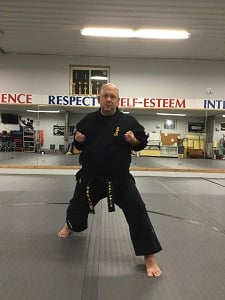What Do You Call a Stance in Martial Arts
The Importance of Stance
No quod sanctus instructior ius, et intellegam interesset duo. Vix cu nibh gubergren dissentias. His velit veniam habemus ne. No doctus neglegentur vituperatoribus est, qui ad ipsum oratio. Ei duo dicant facilisi, qui at harum democritum consetetur.
Past Guest Blogger: Alvin Myers Movement, balance, and range are crucial parts of sparring and training in martial arts. These things are all tied into opinion. Without the correct stance, y'all cannot movement correctly, position yourself for strikes, or use your range most effectively. When nosotros hash out the importance of stance with our students, practise we really review it all? I know personally during kata practice I may say to a student: "Picket your stance!" Or, during line drills: "Go on a strong stance!" merely exercise we take the fourth dimension enough time to break downward for our students what it means to have a good stance? In this article I will provide a cursory outline of the bones stances my school uses in our karate. I've realized that I utilise certain minimal phrases to describe them, when a more detailed definition is called for. Fighting Stance What we say: "Stand with your feet a shoulder width autonomously side to side and front end to dorsum." The missing details: We tend to forget mentioning this, but it'due south important to clarify for our students: This opinion is meant to allow you to motion in or away from an opponent without stumbling or getting wrapped up. Your anxiety should be at the aforementioned distance, but your knees must be slightly bent, likewise. This will let you to motion in all directions, forward, backward, left and correct, and to switch feet easily. Forward Leaning or Zenkutsu Dachi Opinion What nosotros say: "Stand with one leg forward and the knee bent. The rear leg should exist kept direct." The missing details: As we know, the details of this stance in kata and fighting are crucial. A modest but critical item to note is that we should sink downwards a consummate caput-tiptop lower, and our legs should be equally broad as our shoulders to help maintain stability. This volition help to keep us from falling over if pushed. Horseback or Kiba Dachi Stance What nosotros say: "Stand with your feet a shoulder width apart and bend your knees as if sitting upon a horse." The missing details: We overlook that even this seemingly uncomplicated opinion can exist performed incorrectly. Y'all can tell this opinion is wrong if yous appear to have an "A-frame" stance. The A-frame stance is when you are not sitting low plenty in your stance. In the A-frame, your knees will barely be aptitude, and your hips not pushed back. Back Leaning or Kokutso Dachi Stance What we say: "Go on your rear leg bent with nearly of the weight on information technology, and your front end leg straight." The missing details: The specifics of this stance are of import. You lot should have 90% of your weight on the rear leg and ten% on the front leg. You should be sitting back on the rear leg, with that knee bent. The small amount of weight on your lead leg should be in the brawl on your pes, not your heel. This allows that leg to move and kicking quickly. Hourglass or Sanchin Dachi Stance What we say: "Stand with 1 foot forward and your knees pointed slightly inwards." The missing details: Sanchin Dachi isn't as common as the others, and often, it's forgotten about altogether. Nevertheless, this stance does have some benefits, like a proficient lower centre of gravity and the ability to defend yourself better in a cornered situation. The frontwards foot is turned with toes pointing inwards and the heel pushed out. The rear leg does the same, but the toes should line up with the heel of your forward foot. Both knees should exist bent slightly inward, but not so far that information technology causes discomfort to the joint (because of this, I've heard more one person refer to this as the "potty stance" – hey, any gets your students to remember it!). I hope you found this article useful! You lot're welcome to employ my descriptions, or, if these aren't stances your school teaches, I hope it inspires yous to take a similar look at your ain explanations of the stances you do use! Remember, our students want to do their best, and giving them all the details will help them grow.







Source: https://blog.centurymartialarts.com/the-importance-of-stance
0 Response to "What Do You Call a Stance in Martial Arts"
Post a Comment